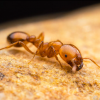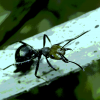So according to the sheer amount of space these ants have taken over, here are the top three (I picked the ones that everyone else picked to compare, and show the rankings based on that.)
So in first place, having a presence in about 85% (a very rough estimate) of the Earth's landmass, is the Pharaoh ant, Monomorium pharaonis. They live pretty much in most places.
In second place, we have the Argentine ant, or Linepithema humile. They have taken over a ton of countries, and are known for their ability to form super colonies, which is definitely an advantage for them.
And third, Solenopsis invicta, or the RIFA (red imported fire ant), which actually hasn't been seen in quite a few countries, but is VERY prolific, with their brutal stings and reproduction speed.
It should be noted that Anoplolepis gracilipes is, yes, also very prolific, and have spread about the same amount as RIFA, according to ant maps, anyways.
It should also be noted that technically ants don't regard borders as anything, so there's probably the occasional colony in another country.
Edited by Stubyvast, June 25 2024 - 9:14 AM.
Manica invidia (1 queen, ~200 workers)
Manica invidia (1 colonies, 1 queens plus 3 workers)
Lasius niger (single queen, ~200 workers - naturalistic, predatory set-up)
Lasius americanus (1 colony, ~10 workers)
Tetramorium immigrans (3 colonies, 3 queens, ~ five workers each | 1 colony, 1 queen, ~1200 workers)
Formica aserva (aserva queen, ~15 Formica neorufibarbis workers)
"And God made...everything that creeps on the ground according to its kind.
And God saw that it was good." - Genesis 1:25

















